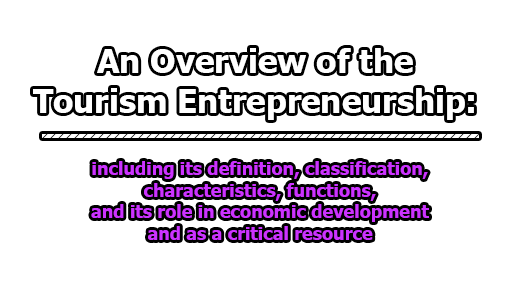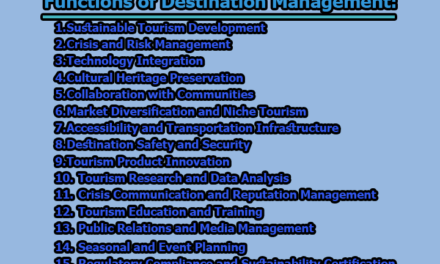An Overview of the Tourism Entrepreneurship:
Tourism entrepreneurship refers to the process of identifying, creating, and developing a new business venture in the tourism industry. It involves recognizing opportunities to provide tourism-related products or services that meet the needs and preferences of travelers and then designing and implementing a strategy to turn those ideas into a profitable and sustainable business. Tourism entrepreneurship can take many forms, from starting a small tour company to launching an online travel booking platform to developing a new tourist attraction or experience. Successful tourism entrepreneurs are often innovative, creative, and customer-focused, and they are able to identify and respond to emerging trends and changing consumer preferences in the tourism industry. In the rest of this article, we will present you with an overview of the tourism entrepreneurship; including its definition, classification, characteristics, functions, and its role in economic development and as a critical resource.
Definitions of Tourism Entrepreneurship:
Some of the necessary definitions are given below:
“Tourism entrepreneurship refers to the process of identifying, creating, and developing a new business venture in the tourism industry.” (UNWTO, 2016, p. 13)
“Tourism entrepreneurship is the act of creating and managing a business venture in the tourism industry. This includes identifying opportunities to offer tourism-related products or services, as well as developing and implementing strategies to bring those offerings to market.” (Mura & De Carlo, 2017, p. 32)
“Tourism entrepreneurship involves the creation and management of a business that provides innovative and unique tourism experiences to visitors. It requires identifying market opportunities, developing a competitive product, and providing high-quality service to satisfy customer needs.” (Jamal & Getz, 1995, p. 27)
“Tourism entrepreneurship is the process of identifying and exploiting business opportunities in the tourism industry. It involves creating and delivering value to customers, while also generating sustainable profits for the business.” (Hall & Williams, 2008, p. 11)
“Tourism entrepreneurship refers to the process of developing and managing a business venture in the tourism industry, with the aim of creating value for customers, employees, and shareholders. This involves identifying market needs, designing innovative products or services, and delivering them in a sustainable and responsible manner.” (Chiu & Yang, 2019, p. 216)
Classification of Tourism Entrepreneurship:
Tourism entrepreneurship is a complex and multifaceted phenomenon, encompassing a wide range of business activities and strategies in the tourism industry. Scholars and practitioners have proposed various ways to classify tourism entrepreneurship, depending on the perspective, context, and purpose of the classification. Here, we will explore some of the most common classifications of tourism entrepreneurship and discuss their strengths and limitations.
- Type of entrepreneurship: One way to classify tourism entrepreneurship is based on the type of entrepreneurship, such as:
- Lifestyle entrepreneurship: This type of entrepreneurship is characterized by the desire to create a business that supports a particular lifestyle, such as travel, leisure, or culture. Lifestyle entrepreneurs are often motivated by personal fulfillment, autonomy, and creativity, rather than profit maximization.
- Necessity entrepreneurship: This type of entrepreneurship arises from the need to generate income and employment opportunities in the context of limited or unstable job options. Necessity entrepreneurs often start small and informal businesses that require little capital or skills, such as street vending, handicrafts, or food services.
- Opportunity entrepreneurship: This type of entrepreneurship stems from the recognition of a market opportunity or a gap in the tourism industry that can be exploited by a new or existing business. Opportunity entrepreneurs often have a high degree of innovation, risk-taking, and growth orientation, and may seek external funding or support to scale up their businesses.
Strengths: This classification helps to understand the diverse motivations and contexts that drive tourism entrepreneurship, and can inform policies and programs that cater to different types of entrepreneurs.
Limitations: The boundaries between these types of entrepreneurship can be blurred, and entrepreneurs may shift from one type to another depending on the circumstances. Moreover, the focus on the individual motivations of entrepreneurs may neglect the broader social, economic, and institutional factors that influence their success.
- Stage of development: Another way to classify tourism entrepreneurship is based on the stage of development of the business, such as:
- Nascent entrepreneurship: This stage refers to the early phase of business creation, when the entrepreneur is still in the process of developing the idea, testing the feasibility, and seeking resources and support. Nascent entrepreneurs may face high uncertainty, information asymmetry, and resource constraints, and may rely on personal networks or informal sources of funding.
- New venture entrepreneurship: This stage refers to the period of actual business operation, when the entrepreneur has launched the product or service, acquired customers, and started to generate revenue. New venture entrepreneurs may face challenges such as market competition, demand fluctuations, operational efficiency, and financial sustainability.
- Established entrepreneurship: This stage refers to the period of maturity and growth of the business, when the entrepreneur has achieved a stable and profitable operation, expanded the customer base and product portfolio, and may consider diversification, franchising, or internationalization. Established entrepreneurs may face challenges such as innovation, quality control, brand management, and succession planning.
Strengths: This classification helps to understand the dynamic nature of tourism entrepreneurship, and the different challenges and opportunities that entrepreneurs face at different stages of business development. It can also inform policies and programs that target specific stages of entrepreneurship, such as business incubation, mentoring, or access to finance.
Limitations: The boundaries between these stages can be arbitrary and context-dependent, and entrepreneurs may experience multiple stages simultaneously or in a nonlinear way. Moreover, the focus on the internal characteristics of the business may neglect the external factors that affect its success, such as the market environment, the regulatory framework, or the social and cultural context.
- The focus of entrepreneurship: A third way to classify tourism entrepreneurship is based on the focus of entrepreneurship, such as:
- Product entrepreneurship: This type of entrepreneurship focuses on the creation and delivery of tourism products or services, such as tour packages, accommodations, attractions, or events. Product entrepreneurs may differentiate themselves from competitors by offering unique, high-quality, or customized products, or by targeting specific niche markets.
- Process entrepreneurship: This type of entrepreneurship focuses on the improvement and innovation of the business processes that support the creation and delivery of tourism products or services, such as marketing, distribution, operations, or customer service. Process entrepreneurs may seek to reduce costs, increase efficiency, or enhance customer satisfaction by adopting new technologies, management systems, or organizational structures.
- Social entrepreneurship: This type of entrepreneurship focuses on the creation of social and environmental value in addition to economic value, by addressing social or environmental problems through tourism-related activities. Social entrepreneurs may pursue goals such as poverty reduction, community development, cultural preservation, or environmental conservation, and may collaborate with stakeholders such as local communities, NGOs, or governments.
Strengths: This classification helps to understand the different dimensions of entrepreneurship beyond the economic aspects, and the potential of tourism entrepreneurship to contribute to sustainable development and social welfare. It can also inform policies and programs that encourage or reward social and environmental entrepreneurship, such as certification schemes, impact investment, or social innovation hubs.
Limitations: The boundaries between these focuses can be blurred, and entrepreneurs may pursue multiple focuses simultaneously or in a sequential way. Moreover, the focus on the positive outcomes of social entrepreneurship may neglect the trade-offs and challenges that entrepreneurs face in balancing social, environmental, and economic objectives.
- The scale of entrepreneurship: A fourth way to classify tourism entrepreneurship is based on the scale of entrepreneurship, such as:
- Microentrepreneurship: This scale refers to businesses that employ fewer than 10 people and have a low turnover and limited market reach. Micro entrepreneurs may operate from home or small premises and may rely on family labor, informal networks, or self-financing.
- Small entrepreneurship: This scale refers to businesses that employ between 10 and 49 people and have a higher turnover and broader market reach than micro-enterprises. Small entrepreneurs may operate in multiple locations, serve diverse customer segments, and may seek external financing or partnerships to expand their businesses.
- Medium entrepreneurship: This scale refers to businesses that employ between 50 and 249 people and have a significant impact on the local or regional economy. Medium entrepreneurs may have a well-established brand, a diversified product portfolio, and a strategic vision for growth and innovation.
- Large entrepreneurship: This scale refers to businesses that employ more than 250 people and have a global or national presence in the tourism industry. Large entrepreneurs may operate in multiple sectors and countries, have a strong corporate identity, and may face regulatory or political challenges related to their size and market power.
Strengths: This classification helps to understand the different contributions and challenges of tourism entrepreneurship at different scales, and can inform policies and programs that cater to the needs of different scales of entrepreneurship, such as tax incentives, business networks, or internationalization support.
Limitations: The boundaries between these scales can be arbitrary and context-dependent, and entrepreneurs may face different challenges and opportunities depending on the sector, region, or market. Moreover, the focus on the quantitative aspects of scale may neglect the qualitative aspects of entrepreneurship, such as innovation, quality, and social impact.
Characteristics and Qualities of Tourism Entrepreneurship:
Here are some key characteristics and qualities of tourism entrepreneurship:
- Creativity and innovation: Tourism entrepreneurs need to be creative and innovative to develop unique, attractive, and differentiated tourism products and services. They need to identify gaps in the market, understand customer needs and preferences, and come up with new and exciting ways to meet those needs. Creativity and innovation can also help tourism entrepreneurs to stand out in a crowded market and differentiate themselves from competitors.
- Risk-taking and resilience: Starting and running a tourism business involves taking risks, such as investing time, money, and resources without a guaranteed return. Tourism entrepreneurs need to have the courage and confidence to take calculated risks, and to bounce back from setbacks and failures. Resilience is also important in the face of external factors such as economic downturns, natural disasters, or pandemics, which can disrupt tourism demand and operations.
- Vision and strategic thinking: Tourism entrepreneurs need to have a clear and compelling vision of what they want to achieve with their business and a strategic plan for how to get there. They need to be able to identify and prioritize goals, set targets and milestones, and make strategic decisions based on market trends, customer feedback, and competitive analysis. Vision and strategic thinking can also help tourism entrepreneurs to align their businesses with larger societal or environmental goals, such as sustainable tourism development.
- Opportunity recognition and exploitation: Tourism entrepreneurs need to be able to spot and seize opportunities in the market, such as emerging trends, unmet needs, or changing customer behaviors. They need to have a good understanding of the market dynamics, and the ability to adapt and pivot their business model to capitalize on these opportunities. Opportunity recognition and exploitation can also help tourism entrepreneurs to stay ahead of the competition and create new value for their customers.
- Customer orientation and market responsiveness: Tourism entrepreneurs need to be customer-centric and responsive to market demands, preferences, and feedback. They need to understand their target customers’ needs, expectations, and behaviors, and to design and deliver tourism products and services that meet or exceed those needs. Customer orientation and market responsiveness can also help tourism entrepreneurs to build loyal and satisfied customer bases, and to foster positive word-of-mouth and reputation.
- Resourcefulness and adaptability: Tourism entrepreneurs need to be resourceful and adaptable, especially in the face of limited resources or unexpected challenges. They need to be able to find creative and cost-effective solutions to problems and to be flexible and agile in their operations and management. Resourcefulness and adaptability can also help tourism entrepreneurs to optimize their resource utilization, minimize waste, and improve efficiency.
- Networking and collaboration: Tourism entrepreneurs need to build and leverage networks and partnerships to access resources, knowledge, and opportunities. They need to be able to establish and maintain relationships with stakeholders such as suppliers, customers, investors, or regulators, and to collaborate with them on joint ventures, projects, or initiatives. Networking and collaboration can also help tourism entrepreneurs to learn from others, exchange best practices, and enhance their social and cultural capital.
- Passion and commitment: Tourism entrepreneurs need to have a strong sense of passion and commitment to their business and its goals. They need to be motivated by a sense of purpose, a desire to create something new and valuable, and a willingness to work hard and persist in the face of challenges. Passion and commitment can also help tourism entrepreneurs to inspire and motivate their team members, and to create a positive and supportive organizational culture.
- Financial and business acumen: Tourism entrepreneurs need to have a good understanding of finance and business management, such as accounting, budgeting, marketing, or human resources. They need to be able to manage their finances, allocate their resources effectively, and make sound financial and strategic decisions. Financial and business acumen can also help tourism entrepreneurs to attract investment and financing, negotiate favorable contracts, and achieve profitability and sustainability.
- Leadership and team-building: Tourism entrepreneurs need to be effective leaders who can inspire, motivate, and guide their team members toward shared goals. They need to be able to delegate tasks, provide feedback and coaching, and foster a positive and productive work environment. Leadership and team-building can also help tourism entrepreneurs to build a strong and cohesive team, and to develop the skills and talents of their employees.
- Social and environmental responsibility: Tourism entrepreneurs need to be aware of and responsive to the social and environmental impacts of their business, and to take proactive measures to mitigate or address these impacts. They need to be committed to ethical and sustainable tourism practices, such as minimizing waste and pollution, supporting local communities and cultures, or conserving natural resources and biodiversity. Social and environmental responsibility can also help tourism entrepreneurs to enhance their reputation and brand value, and to attract customers who value responsible and sustainable tourism.
- Continuous learning and improvement: Tourism entrepreneurs need to be lifelong learners who are open to new ideas, knowledge, and experiences. They need to be able to reflect on their performance, seek feedback and advice, and engage in continuous learning and improvement. Continuous learning and improvement can also help tourism entrepreneurs to stay up-to-date with market trends and best practices, innovate and adapt their business model, and enhance their competitiveness and resilience.
Functions of Tourism Entrepreneurship:
Tourism entrepreneurship plays a critical role in driving innovation, growth, and competitiveness in the tourism industry. As a dynamic and multifaceted field, tourism entrepreneurship involves a range of functions that contribute to the creation, development, and management of tourism businesses and products. Here, we will discuss the key functions of tourism entrepreneurship and their importance for the tourism industry.
- Opportunity recognition and idea generation: One of the primary functions of tourism entrepreneurship is to identify and evaluate business opportunities in the tourism market. This involves conducting market research, analyzing trends and consumer behavior, and generating ideas for new products or services that meet customer needs and preferences. By recognizing and exploiting untapped or underserved market niches, tourism entrepreneurs can create value for customers and generate competitive advantages for their businesses.
- Business planning and development: Once a business opportunity has been identified, tourism entrepreneurs need to develop a comprehensive business plan that outlines the key aspects of their business, such as the market, the target audience, the products or services, the pricing and distribution strategies, the marketing and promotion activities, and the financial projections. Business planning and development are crucial functions of tourism entrepreneurship, as they help entrepreneurs to clarify their vision and goals, identify potential challenges and risks, and secure financing and resources for their business.
- Product and service design and innovation: Tourism entrepreneurs need to be creative and innovative in designing and developing tourism products and services that offer unique and compelling experiences to customers. This may involve creating new products or services from scratch, or adapting and improving existing ones to meet changing market needs and trends. Product and service design and innovation are important functions of tourism entrepreneurship, as they can help entrepreneurs to differentiate their business from competitors, enhance customer satisfaction and loyalty, and foster repeat business and referrals.
- Marketing and promotion: Effective marketing and promotion are essential functions of tourism entrepreneurship, as they help entrepreneurs to reach and attract potential customers, build brand awareness and reputation, and generate sales and revenue. This may involve developing a marketing plan that includes a mix of advertising, public relations, direct marketing, and digital marketing activities, such as social media, search engine optimization, and content marketing. Marketing and promotion strategies should be tailored to the specific needs and preferences of the target audience and aligned with the overall business strategy and goals.
- Sales and distribution: Once a tourism product or service has been developed and marketed, tourism entrepreneurs need to ensure that it is distributed and sold effectively to customers. This may involve partnering with travel agencies, tour operators, online travel agencies, or other intermediaries to reach a wider audience and generate more bookings. Sales and distribution functions of tourism entrepreneurship also involve managing inventory, pricing, and revenue management strategies to optimize profitability and customer satisfaction.
- Financial management and control: Tourism entrepreneurs need to have a sound understanding of financial management and control, as this is essential for ensuring the sustainability and profitability of their business. This may involve developing financial projections, managing budgets, tracking and analyzing financial performance, and making strategic financial decisions that align with the overall business strategy and goals. Financial management and control functions of tourism entrepreneurship also involve managing cash flow, managing debt and financing, and minimizing financial risks and exposure.
- Human resource management and development: Tourism entrepreneurs need to manage and develop their human resources effectively, as their employees are critical to the success and sustainability of their business. This may involve recruiting, hiring, and training employees, providing ongoing coaching and feedback, fostering a positive and productive work environment, and developing employee retention and motivation strategies. Human resource management and development functions of tourism entrepreneurship also involve managing employee performance, ensuring compliance with labor laws and regulations, and fostering a diverse and inclusive workplace culture.
- Quality management and customer service: Quality management and customer service are essential functions of tourism entrepreneurship, as they are key drivers of customer satisfaction, loyalty, and repeat business. Tourism entrepreneurs need to ensure that their products and services meet or exceed customer expectations in terms of quality, safety, reliability, and consistency. This may involve developing quality management systems, conducting regular audits and assessments, and implementing continuous improvement processes. Tourism entrepreneurs also need to provide excellent customer service and support, by responding to customer inquiries and complaints promptly and effectively, and by building long-term relationships with customers based on trust, respect, and empathy.
- Environmental and social responsibility: Tourism entrepreneurship has a significant impact on the natural and social environments in which it operates. As such, tourism entrepreneurs need to be aware of their environmental and social responsibilities and adopt sustainable and responsible practices that minimize negative impacts and maximize positive contributions. This may involve reducing energy and water consumption, reducing waste and pollution, supporting local communities and cultures, and promoting the conservation and preservation of natural resources and heritage sites. Environmental and social responsibility functions of tourism entrepreneurship also involve complying with relevant laws and regulations, engaging in stakeholder consultation and dialogue, and reporting on sustainability performance and achievements.
Role of Tourism Entrepreneurship in Economic Development:
Tourism entrepreneurship plays a crucial role in the economic development of countries by creating job opportunities, generating income, promoting foreign exchange earnings, and contributing to the overall growth of the tourism industry.
- Job Creation: Tourism entrepreneurship creates employment opportunities in various sectors of the economy, such as accommodation, transportation, food and beverage, entertainment, and other related services. The tourism industry is one of the largest employers in the world, accounting for around 10% of total employment globally. In developing countries, tourism entrepreneurship can play a vital role in creating jobs for local communities, especially in rural areas where employment opportunities are limited.
- Income Generation: Tourism entrepreneurship generates income for entrepreneurs, employees, and the government. Tourism entrepreneurs create businesses that generate revenue through the sale of goods and services to tourists. Employees working in the tourism industry earn salaries and wages, which contribute to their livelihoods and the local economy. The government also generates income through taxes, fees, and other charges levied on tourism businesses.
- Foreign Exchange Earnings: Tourism entrepreneurship promotes foreign exchange earnings by attracting foreign tourists to a destination. Foreign tourists bring in foreign currency, which contributes to the balance of payments of a country. Tourism is a significant source of foreign exchange earnings in many developing countries, where other export industries are not well developed.
- Infrastructure Development: Tourism entrepreneurship contributes to the development of infrastructure in a destination. Tourism entrepreneurs invest in the development of accommodation, transportation, entertainment, and other related services, which leads to the creation of new infrastructure. This new infrastructure attracts more tourists, leading to increased economic activity in the destination.
- Economic Diversification: Tourism entrepreneurship promotes economic diversification by creating opportunities for new businesses to emerge. Tourism entrepreneurs often create new products and services that cater to the needs and preferences of tourists, leading to the emergence of new businesses. These new businesses contribute to the overall economic development of a destination, leading to increased employment opportunities and income generation.
- Regional Development: Tourism entrepreneurship contributes to the development of regional economies by creating economic linkages between urban and rural areas. In many cases, tourism businesses are located in rural areas, where the natural and cultural attractions are located. These businesses create jobs and income opportunities for local communities, leading to the development of the regional economy.
- Promotion of Local Culture and Heritage: Tourism entrepreneurship promotes local culture and heritage by developing products and services that showcase the unique features of a destination. Tourism entrepreneurs create cultural tours, heritage walks, and other related products that highlight the local culture and heritage of a destination. This promotes cultural exchange and understanding between tourists and local communities, leading to the preservation and promotion of local culture and heritage.
Tourism Entrepreneurship as Critical Resources:
Tourism entrepreneurship is a critical resource that plays a significant role in the success and sustainability of the tourism industry. It refers to the creation and management of businesses that provide products and services to tourists. Tourism entrepreneurs are critical resources because they bring innovation, creativity, and new ideas to the tourism industry. Here, we will discuss how tourism entrepreneurship can be viewed as a critical resource.
- Innovation: Tourism entrepreneurs are critical resources because they bring innovation and creativity to the tourism industry. They develop new products and services that cater to the changing needs and preferences of tourists. For example, some entrepreneurs develop eco-friendly and sustainable tourism products that appeal to environmentally conscious travelers. These products and services add value to the tourism industry, leading to increased competitiveness and sustainability.
- Job Creation: Tourism entrepreneurship is a critical resource because it creates employment opportunities in various sectors of the economy. Tourism businesses such as hotels, restaurants, tour operators, and transport services employ millions of people globally. Tourism entrepreneurship can play a vital role in creating jobs for local communities, especially in rural areas where employment opportunities are limited.
- Economic Growth: Tourism entrepreneurship is a critical resource because it contributes to the economic growth of countries. The tourism industry is one of the largest and fastest-growing industries globally, accounting for around 10% of the world’s GDP. Tourism entrepreneurship can lead to the creation of new businesses, increased foreign exchange earnings, and the development of infrastructure, all of which contribute to the economic growth of countries.
- Development of Local Communities: Tourism entrepreneurship is a critical resource because it contributes to the development of local communities. Tourism businesses often source their products and services from local communities, leading to the creation of income and employment opportunities for local residents. Additionally, tourism entrepreneurs often engage in corporate social responsibility initiatives that benefit local communities, such as the construction of schools, hospitals, and other infrastructure.
- Knowledge Transfer: Tourism entrepreneurship is a critical resource because it facilitates the transfer of knowledge and expertise. Tourism entrepreneurs often have extensive knowledge and expertise in various aspects of the tourism industry, such as marketing, management, and product development. They can share this knowledge with local communities and other entrepreneurs, leading to the creation of new businesses and the development of the tourism industry.
- Sustainable Tourism: Tourism entrepreneurship is a critical resource because it promotes sustainable tourism practices. Tourism entrepreneurs often adopt sustainable practices such as using renewable energy sources, reducing waste, and conserving natural resources. These practices not only benefit the environment but also contribute to the long-term sustainability of the tourism industry.
- Cultural Preservation: Tourism entrepreneurship is a critical resource because it promotes the preservation of local culture and heritage. Tourism entrepreneurs often develop products and services that showcase the unique features of a destination, such as cultural tours, heritage walks, and other related products. These products promote cultural exchange and understanding between tourists and local communities, leading to the preservation and promotion of local culture and heritage.
It is apparent that tourism entrepreneurship is an essential aspect of the tourism industry, as it brings innovation, creativity, and new ideas to the industry. It also contributes to the economic growth of countries, job creation, and the development of local communities. Tourism entrepreneurship promotes sustainable tourism practices, and cultural preservation, and facilitates knowledge transfer. However, tourism entrepreneurship plays a crucial role in the success and sustainability of the tourism industry. By recognizing its importance, policymakers and industry stakeholders can create an enabling environment that supports the development of tourism entrepreneurship, leading to the long-term success and sustainability of the tourism industry.
References:
- Altinay, L., Madanoglu, M., & Daniele, R. (2015). Tourism entrepreneurship in peripheral destinations: The case of North Cyprus. Journal of Destination Marketing & Management, 4(2), 109-119.
- Carbone, V., & Simeone, M. (2018). The role of entrepreneurship in the development of rural tourism: Evidence from Italy. Journal of Rural Studies, 57, 44-53.
- Chikweche, T., & Fletcher, R. (2012). Small tourism firms and entrepreneurship in developing countries: A critical review. Tourism Management Perspectives, 2-3, 27-34.
- Hall, C. M., & Williams, A. M. (2018). Tourism and innovation. Routledge.
- Jamal, T., & Getz, D. (1995). Collaboration theory and community tourism planning. Annals of Tourism Research, 22(1), 186-204.
- Mason, P. (2015). Tourism impacts, planning, and management. Routledge.
- Sharpley, R. (2014). Hosts and guests revisited: Tourism issues of the 21st century. Channel View Publications.
- Shaw, G., Bailey, A., & Williams, A. M. (2011). Aspects of service-dominant logic and its implications for tourism management: Examples from the hotel industry. Tourism Management, 32(2), 207-214.
- Smith, S. L. J., & Jenner, P. (2011). Understanding tourism entrepreneurship. Goodfellow Publishers.
- Williams, A. M., & Shaw, G. (2011). Internationalization and innovation in tourism. Annals of Tourism Research, 38(1), 27-51.
- Gartner, W. B. (1985). A conceptual framework for describing the phenomenon of new venture creation. Academy of Management Review, 10(4), 696-706.
- Aguiló, E., Riera, A., & Mulet, F. (2005). Entrepreneurship in the Balearic Islands’ hotel industry. Annals of Tourism Research, 32(1), 139-156.
- Biagi, B., & Detotto, C. (2012). Entrepreneurship and the development of global wine tourism in Sardinia. Journal of Travel Research, 51(2), 218-229.
- Buhalis, D., & Costa, C. (2006). Tourism business frontiers: Consumers, products, and industry. Elsevier.
- Carr, N., & Cohen, B. (2011). Small firms as international players—A critique of contemporary international business research through the lens of network theory. International Business Review, 20(6), 668-680.
- Edwards, D., & Hall, C. M. (2013). Tourism and regional development: New pathways. Routledge.
- Fayolle, A., & Liñán, F. (2014). The future of research on entrepreneurial intentions. Journal of Business Research, 67(5), 663-666.
- Hjalager, A. M., & Edwards, D. (2013). Tourism and entrepreneurship: International perspectives. Routledge.
- Leitão, J., & Garrido-Morgado, A. (2015). Entrepreneurship in tourism: A review of the literature. Tourism & Management Studies, 11(2), 15-23.
- Mariussen, A. (2013). Handbook on the economics of leisure. Edward Elgar Publishing.

Library Lecturer at Nurul Amin Degree College










